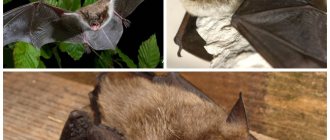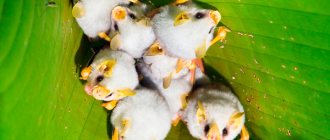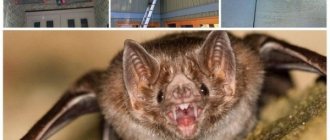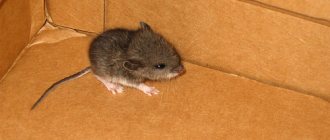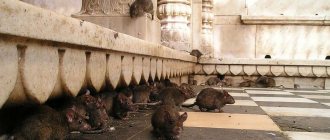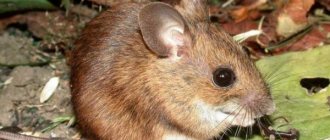Home Bats How do bats live and where do they live in winter?
One of the most interesting and mysterious living creatures, the true nature of which does not at all correlate with the mythical ominous rumors and ideas of our “dark” ancestors. In fact, bats are more beneficial than other members of the human race.
And we will try to talk about these amazing nocturnal animals, or more precisely, about how they live, where they spend the cold winter and when bats wake up after hibernation.
- Who are they, creatures of evil or faithful helpers?
- Hibernation of bats
- Take care of our little brothers
- Conclusion
Do they all spend the winter where they live?
Not all types of flying animals spend the winter where they spend the summer months. Some varieties fly to warmer places, just like birds. But many species of these animals remain to spend the winter where they live.
Among the mice remaining for the winter, the following species are most common:
- nocturnal;
- earflaps;
- nightlights.
Animals of these species find suitable secluded places and fall into long suspended animation, lasting up to six months. However, if a person manages to find a place where a bat hibernates and accidentally or intentionally disturbs the animal, then the animals, despite the cold weather, fly away in search of a new shelter. Such forced migrations significantly harm the health of animals and can cause the fact that with the onset of warmer weather, some animals will not wake up, that is, they will die.
Hibernation of bats
One may wonder why in winter one cannot see the flickering shadows of bats in the frosty darkness of the night, as in summer. In fact, the question will not be very appropriate, since these creatures cannot stand the cold.
In addition, these are insectivorous animals and, in addition to the unacceptable temperature of the outdoor environment, they are faced with the problem of loss of food sources.
Most species of bats, pipistrelle bats, for example, with the onset of autumn cold weather, leave the places where they lived and fed in the summer, and migrate to warmer latitudes, such as the southern regions of China and other Asian countries, where the winter season is much milder and the temperature is not falls below 2-3 degrees above zero.
But some species of these night hunters, such as bats and long-eared bats, show real patriotism and stay for the winter.
At the same time, they stop all active activity and fall into hibernation. But it must be said that this is not a bear's endless winter. Bats may wake up from time to time in order to assess the situation, especially if it is not conducive to continuing a further stay in the monastery chosen for the winter.
But still, in the absence of irritating factors, these animals can fall into deep anabiosis and sleep soundly for 2-5 months. At the same time, the biorhythm of their life slows down very sharply. The heart rate decreases by 50 times (!), and the body temperature drops to 4 degrees, while the animal can take one breath every 10-15 seconds.
Immersion in suspended animation in bats has an exclusively protective “adaptive” nature. That is, it is the physiological adaptability of the body to change its rhythm of life during periods of unfavorable living conditions. This is how they survive during periods of lack of food and low temperatures.
Hollow trees, attics of houses, caves and dungeons, empty mines, insulated cellars and vegetable storages can serve as winter shelter for sleeping bats. Simply put, they need a place inaccessible to other living creatures with a temperature of at least 8 degrees, without drafts and with high humidity.
The duration of hibernation can vary among different species from 2-2.5 months to six months, and even longer.
Bats usually hibernate in large families, with their paws hooked onto something horizontal, hanging upside down and wrapping their wings around themselves. If you take a sleeping animal in your hands, you might think that it is dead. But after a while, having warmed up in warm hands, he will realize that he is in trouble and will definitely try to escape. Having been released, after some time he will again join his sleeping brothers.
Bats have an excellent memory, and they perfectly remember the location of that cave or that attic where they managed to safely overwinter the last cold period. They actually develop a very strong attachment to their usual hibernation place.
And we are talking here not only about a specific geographical point on the map of the area. Moreover, the researchers were able to notice that the awakened bat tries to take the very place in the “winter apartment” where it slept before awakening.
To the question of when bats wake up after terrestrial hibernation, we note that much depends on the species and specific circumstances. Representatives of the bat order, more resistant to cold, can wake up as early as March, if the beginning of spring is not too wintry and frosty. More heat-loving species, such as moths, can sleep a little longer, until mid-May, especially if the winter has been long.
At the same time, when waking up, the animals shake for some time, as it might seem from the outside. They are shaking as if with a fever, but this is not at all due to the fact that the bat is freezing. No, this is how their body warms up after winter suspended animation.
By contracting muscles, animals very quickly and sharply increase their body temperature from several degrees to 30. After which the bat begins its new summer season of active work and reproduction.
In what month do bats hibernate? When should you start feeding?
There is practically no point in feeding the animal once. The animal needs long-term feeding if its reserves of subcutaneous fat are running low. You can find out only by weighing the animal on a scale. If you do not have scales, contact your nearest veterinary clinic and ask them to weigh your animal. If you do not have the opportunity to feed the animal, or its weight is within the normal range, then you should place the animal in the cold for the winter as soon as possible (which will be written about later). In the warmth, the bat burns its fat reserves, which will help it survive the winter, and will soon die.
In bats with short fur, such as rufous noctules, the degree of fatness can also be determined visually. In the photo on the left is an exhausted bat that requires additional feeding, while on the right is a well-fed one that can continue wintering without any problems. Please note: in an emaciated animal, the depression at the withers, between the shoulder blades, and also the sunken belly are clearly visible. A well-fed animal does not have such depressions - there is a fat reserve at the withers and between the shoulder blades, and the tummy is moderately rounded.
But most native bat species have long fur that hides their body shapes. In this case, you can determine the degree of fatness of the mouse by touch. The presence or absence of fat at the withers and in the area of the shoulder blades can be very clearly felt.
In our practice, we start feeding animals when their weight is below the norm we have established. So, for the rufous noctule it is 27 grams, for the late-colored noctule – 25 grams, for the Kul’s pipistrelle – 7 grams, and the two-colored noctule – 13 grams. Look
If you do not know what species the bat you found belongs to, please send us a photo of the animal by e-mail, VKontakte or Facebook page, and we will help you determine the species. You can also contact us by phone numbers listed on the website.
Appearance of bats
Despite the fact that bats are very different from each other in size and appearance, it is clear from everything that they are bats and nothing else. The bat's body is covered with fur, which always has a lighter shade on the abdomen. The wingspan varies from 15 cm to almost 2 m, and what shapes do these wing arms take! However, no matter how long and narrow, no matter how short and wide, the wings of bats always have the same structure.
The forelimbs of the bat are very well developed; her short shoulders are strong, and her very long forearm is formed by just one radius bone. The thumb of the forelimb ends in a hooked claw, and the other (very long) fingers support the membranes of the wings located on the sides. The shape of the body and the length of the tail depend on the individual’s belonging to a particular species. A bony projection called a spur helps many species spread their wings all the way to the tail.
Bats fly using membranous wings that move in sync with their hind limbs. The wings, the membranes of which are a double layer of skin, are equipped with muscles and elastic veins, at rest, pressing them tightly to the body.
Where can you find them?
To find a place where a bat hibernates, you need to know what conditions the animal requires for hibernation. Not every attic in a residential building or a cave in the forest is characterized by the qualities necessary for long-term suspended animation. The location must meet certain parameters.
Where the bat hibernates, fairly strict conditions must be met:
- temperature not higher than 8 degrees Celsius, but not lower than 7;
- humidity - from 80%;
- no drafts.
The requirements are quite complex, especially for urban areas. For this reason, it is not at all difficult to find a place where bats hibernate in the city. It is enough just to exclude all those places in which the animals will not be comfortable
What does it eat?
What are the food preferences of a rodent, since it chews literally everything that comes its way? He is capable of even such addictions that are difficult to even imagine. They chew holes in wooden, concrete or brick structures. Their diet includes products made from polystyrene foam, plastic or rubber, as well as products from other synthetic materials. In a human home, the vole mouse spoils any food products, but does not disdain grain, bulk food products, vegetables, fruits, etc. meat, lard, sausage, etc.
Interesting to know! The vole mouse stores for the winter if it is in the field, and during the winter it eats everything that it managed to collect during the warm period. As for other representatives of this family that were able to gain access to human reserves, they do not care about supplies for the winter. The rodent stores for itself for the winter food items that are edible. In this case, the amount of reserves depends on the size of the mink. During the day, the mouse eats no more than 5 g of food and drinks up to 20 ml of liquid. Instead of water, rodents consume succulent parts of plants. Around mid-summer, the animal begins to make supplies for the winter.
What's best for them to sleep in?
Mice that stay for the winter in the climatic conditions of the middle zone prefer to do this in the following places:
- abandoned adits and mines;
- insulated attics of non-residential old houses and basements;
- deep and dry wells;
- large hollows;
- branched grottoes or caves.
Mice can spend the winter in any other suitable places. For example, among the shelters where bats spend the winter in Russia, one of the first positions is occupied by abandoned pipelines and buildings. Large pipes under rural bridges, in which streams or rivers used to flow, can also become a haven for animals. True, only in the southern regions of the country. They also make their winter quarters in the ruins of churches, estates and other ancient buildings.
Where do bats live in winter? Where bats hibernate
There are such funny animals - bats. Many people are afraid of them, but in fact they are quite harmless. They spend the summer in the forests, but where do they spend the winter?! It turns out that in our area they choose caves and adits in the Zhiguli Mountains for this. Moreover, it is considered the largest wintering site for bats in Europe.
“Chiropteran hunters” have chosen the Shiryaevsky adits. Three “Red Book” species also winter here. For example, the northern leatherback is an inhabitant of the taiga and is a very rare animal in our region. But brown long-eared mice are not listed in the Red Book, but they get the most from people, because these mice settle down for the winter on the walls of adits - lower than others. They hang like this for 7 months - without food and without water, and the body temperature of the bats drops to the ambient temperature, which is +2 degrees.
Under no circumstances should mice be disturbed in this state. If they wake up, they will spend a lot of energy, which they will not be able to replenish, and by the end of winter they will simply die from exhaustion.
At the beginning of 2021, the total number of wintering animals was almost 29 thousand individuals, which is slightly lower than its record value in 2013 - 30 thousand individuals.
These animals are insectivores; they fly remarkably well at night using echolocation. Right in flight, mice knock large insects into a “pocket”—the curved tail part of the membrane—with their wings. Interestingly, by the sound of insects buzzing, bats can recognize whether a midge is edible or poisonous.
Brandt's bats
https://www.samru.ru/relax/hobby/95464.html
During the day, bats sleep. And in winter, before hibernation, bats gather in a kind of “battery”, pressing tightly against each other. This is how they try to warm up, although the mice’s body temperature drops in the cold, breathing and heart rate slow down.
Females bring no more than two babies per year. In general, the number of bats in the Samara region is falling because there are fewer places for hibernation, and insects, due to the large number of drugs that people use to treat fields, become quite harmful prey for bats.
What are the optimal conditions for wintering?
So, if the animal has gained the required weight, then one day after the last feeding it should be placed in a cool place (15 ºС) and then placed in the refrigerator another day later. The optimal temperature for hibernation of bats is 2 – 8 ºС. In apartment conditions, you can place the animal on the balcony or in the refrigerator.
Important factors for successful wintering are stable temperature and high humidity (more than 50%). On the balcony, the temperature often fluctuates, so the refrigerator (compartment for vegetables) is more suitable for bats. Chiropterans do not have an unpleasant odor and will not be interested in your products, so you do not have to be afraid to place the animal in the refrigerator.
If you have a refrigerator with a “no frost” system, then to maintain the humidity the animal needs, you can place a bowl of water next to the box in which it sleeps. Frequent opening of the refrigerator, light and noise will not affect his sleep. Let's repeat the main thing: cold and humidity. If you have a cellar or garage with suitable temperature conditions, then this is also a good option.
If the animal has been fattening for some time, it is better to place it for the winter in the same bag or box in which it lived warmly.
You should not check how the animal sleeps too often, since each awakening is a loss of energy. About once every 3-4 weeks, the animal can be taken out of the refrigerator (or other wintering place), given water, weighed and sent back. If the weight has dropped significantly again, start a new feeding cycle.
We suggest you read: What to do if your cat has frostbitten ears
This should be a shelter with a temperature of 0 8C and a humidity level of 80-100%, without drafts. For the middle zone, such conditions are usually met by dungeons, basements, caves, old mines and adits, deep well log houses, attics, and hollows in trees. Sometimes accumulations of wintering individuals reach several hundred heads. Numerous colonies can settle in old abandoned military pillboxes, many of them in the forts of the Brest fortresses.
If wintering is successful, then the animals remember this place and will definitely return for the next hibernation, because it is becoming more and more difficult for winged animals to find suitable shelters in modern realities.
The place where the bat hibernates is permanent. These animals have a specific memory, and as soon as they find a place that best meets the conditions necessary for wintering, they return to it for years.
Optimal wintering sites
So, where do bats hibernate, do bats hibernate in winter, and where do they sleep?
To successfully overwinter, bats need reliable, draft-free shelter with a temperature of 7-8 degrees to zero (but not lower) and a humidity of 80 to 100%.
In the middle zone, such a winter environment is created in dungeons, caves and basements, mines and adits, in the log cabins of deep wells, in attics, and in the hollows of old trees.
Animals often move to wintering shelters in colonies numbering up to several hundred individuals. Large communities of bats hibernate in empty abandoned pillboxes from the war, in the forts of the Brest Fortress.
Finding a suitable place is not easy, so winged mammals perfectly remember not only the attic, cave or basement itself, but also the specific area where they are located in it. From year to year, bats return exactly to the same place where they have already managed to safely spend the winter.
Field mouse: description
A small rodent can be called differently: field mouse, meadow mouse, simply vole, small mouse, striped mouse. This animal is familiar to many people, since the lives of humans and rodents are often intertwined. With the onset of real winter cold, this pest moves closer to humans, appearing in barns, warehouses, sheds and other outbuildings, as well as in human homes. They often settle in dachas, gardens or personal plots.
It is not difficult to distinguish a field mouse from other rodents by a number of characteristic features. For example:
- It grows in length up to 12 cm, no more, while the average size of a rodent is about 10 cm. The tail of the animal is thin and makes up about 70% of the length of its body.
- The body shape is somewhat oblong with elongated hind feet. When the mouse moves, they protrude forward.
- The muzzle is elongated, with an oblong nose, and the ears are small but round.
Judging by its appearance, it is an attractive and harmless animal. Of particular interest is the mouse's red nose. The body structure of a mouse differs little from the body structure of many species of rodents.
The body is covered with short hair, which is characterized by uneven coloring, while the abdomen is always lighter compared to the rest of the body. The vole can be easily distinguished from other species of rodents by the characteristic black stripe located along the back. The color of the coat may vary depending on living conditions. In summer, the vole has a darker color, but with the arrival of winter, the color changes to lighter. In the images below you can see for yourself how the vole mouse differs from other rodents.
Interesting fact! Rodent teeth are unique in that they grow throughout life. This is especially true for a pair of long incisors, which appear already in the second month of life and grow by 1.5 mm daily. To prevent its teeth from growing excessively, the animal needs to constantly gnaw on something so that they wear down. At the same time, mice gnaw even those objects that have no nutritional value.
The average weight of a vole mouse is no more than 20 grams, although larger individuals are found, weighing up to 30 grams.
How do bats reproduce?
According to known data, bats have inhabited our planet for about 50 million years. Scientists have discovered an almost complete skeleton of an ancestor of bats called Icaronicteris; the find dates back to the Eocene period. These are 8 cm long animals, almost identical to modern bats, so zoologists have not fully decided on their origin and, in particular, it is not known how they learned to fly. It is believed that bats could have evolved from tree-dwelling insectivores.
Although bats are very diverse in appearance, it is difficult to confuse them with other animals. The body of the mouse is covered with fur, which is somewhat lighter on the belly. The wingspan of the species is also huge - from 15 cm to almost 2 m. And the shapes of the wing arms are also very diverse. But, regardless of shape, their wings have the same structure.
The forelimbs of bats are amazingly developed: their shortened shoulders are strong, and their elongated forearms are built from only one radius bone. The thumbs of the forelimbs have hooked claws, and the remaining fingers are balanced by wing membranes located on the sides. The structure of the body and the size of the tail depend on the belonging of the animals to a particular species. A bony process, called a spur, helps to unfold the wings all the way to the tail.
Let's see how bats reproduce. This happens once a year. Most give birth to only one offspring. Some species give birth to a pair, and the hairy-tailed bat or brown bat (a mouse with 4 nipples), which lives in southern Canada and Central America, produces three or even four pups in one litter.
In tropical latitudes, bats bring litter all year round, and in our climatic zones, bats mate in the fall or during hibernation, so that the babies are born in the spring.
Mid-lane bats do not form pairs and often change partners. Sometimes, a baby mouse conceives during the winter: the male fidgets, approaches the nearest female and, in a semi-dormant state, mates with her.
Reproduction of bats in common species occurs during the day. During childbirth, the female is often positioned head down, but more often, she is attached to the side wall of the shelter with her head up. The cubs appear feet first (of all mammals, this is found only in bats), ending up in the mother’s tail pouch.
What happens during hibernation?
In this state, all life processes occurring in the animal’s body are suspended. During active wakefulness, the heart rhythm in these animals averages 420 beats per minute. In a state of suspended animation, the pulse decreases significantly. The rhythm during winter sleep does not exceed 14-16 beats per minute.
Such characteristics as body temperature also change. If you pick up the mouse, it will seem hot and dry. During wakefulness, during the active life period, the body temperature of these animals remains at the level of 37-40 degrees. As soon as the animal falls asleep for a long time, that is, for the entire duration of the upcoming cold weather, the temperature level changes. Moreover, these changes are quite large. The body temperature of a bat in suspended animation is close to zero degrees. To the touch the animal seems not only cold, but also numb.
Hibernation is an important component of the life cycle for these animals. The longer the state of suspended animation lasts, the longer the mouse will live. Stable “entry” into suspended animation and the absence of forced awakenings from hibernation increase the life span for these animals up to 15-20 years.
Who are they, creatures of evil or faithful helpers?
Bats (lat. Microchiroptera) belong to the order Chiroptera of the cohort of placental mammals. These are the only animals in the world capable of prolonged flight.
This is a very extensive order in terms of species, and the sizes of its representatives range from 3 to 50 cm in length, and from 5 to 80 cm in wingspan. But we will consider as a sample not large tropical specimens, but small species inhabiting our European regions, the dimensions of which usually do not exceed the size of a sparrow or tit.
These flyers can live 5-10 years and even longer. Zoologists claim that some bats under scientific supervision lived up to 20-25 years, and this is by no means fiction.
Bats cannot be confused with any other living creature on planet Earth. They have a unique appearance that most may find repulsive and sinister.
The thin limbs of bats resemble a bone frame on which a leather membrane is stretched, forming wings. These creatures have very thick fluffy fur on the body, usually lighter in the front.
The head and muzzle have a truly bizarre structure, with which, in addition to the wings, all the fables about the otherworldly nature of these creatures in the old days were usually associated. And in some ways we can understand both our ancestors and modern, more mannered representatives of the fair sex, who are frightened by just the sight of these funny creatures on TV screens.
The muzzle resembles a pig's snout with large ears, like that devil from the well-known Soviet film adaptation of “Evenings on a Farm near Dikanka” performed by G. Millyar. And two fangs protruding from the upper jaw can cause even greater fear and mistrust.
It must be said that, despite very poor eyesight, these creatures are quite nimble and perfectly oriented in space during flight. In this they are helped by echolocation, that is, the ability to catch the reflection of ultrasonic pulses from surrounding objects.
These animals feed mainly on insects, which they catch in flight with extraordinary dexterity. Tropical bats also eat fruit, and among them are vampire bloodsuckers. However, let's return to our insectivorous night flyers.
Bats are more useful animals for humans. Harm on their part may only consist of the transmission of some dangerous diseases, but this, again, applies to a greater extent to tropical species.
The benefits of bats are especially appreciated in rural areas, where overnight a flock of these creatures can greatly help a farmer who is always suffering from harmful insects.
Also, these creepy-faced flyers serve as plant pollinators, carrying plant pollen on themselves and distributing it over a wide area.
When to release?
If the bat survives until spring, then with the onset of the first consistently warm nights (at air temperatures above zero), the animal can be released. Usually this is the end of March - beginning of April. Also at this time, the first insects appear, and the animal will have something to eat. It should be released after sunset in a park area or outside the city, planted on a hand or on a tree trunk. First give the animal some water and, if there is food left, feed it.
If the bat did not survive until spring, but died during the winter, be sure to give us the frozen corpse. Cadaveric material is necessary for studying the anatomy, physiology and infections of chiropterans.
Chiropterans are the least studied mammals in Ukraine and Russia, so we will be glad to send you letters and photographs about the animals found (date, country, locality, location and features of the find).
Features of behavior
Voles are quite active living creatures, as their metabolic process is quite fast. They need to eat quite often, as they use up their energy quite quickly. Mice have a hard time withstanding hunger, and even more so lack of water. Without food and water, a vole mouse can live no more than 1 week.
Despite such facts, the vole mouse adapts quite quickly to new conditions. Rodents move in certain ways, and they mark their territory with urine. They show their main activity when it gets dark. Under certain conditions, rodents become more active during the day.
Mice are quite cautious living creatures. They react to the slightest sound or rustle, quickly running away to their shelter. This indicates that rodents have many natural enemies and danger lurks at every turn.
The pest tries to constantly stay as close to its hole as possible, moving away from it only a few meters. As a rule, rodents move in tall grass, under bushes or in the shade. Each individual has its own territory marked. They prefer to live in flocks, controlled by dominant males and females.
Interesting to know! The lifespan of individuals in natural conditions is no more than 1 year, although scientists believe that mice can live up to 7 years. The thing is that mice have many natural enemies. In artificial conditions, the average age of rodents is about 3 years.
Trampling and redistributing snow
In order for rodents to get close to such tasty plants - bulbs planted in flower beds and garden beds, bushes and trees - they must make their way through the snow and freely dig a hole or passage. The simplest measure available in winter - trampling down snow - creates a barrier for rodents that is sufficient for effective protection.
They trample down the snow, moving from the perimeter of the tree trunk circles to the trunk, in flower beds - between the plants, trying not to touch them.
Snow is always distributed so that the most vulnerable plants are securely covered, and bare soil is protected from weathering and freezing. In addition, you need to add snow so that in the spring it effectively moistens the soil.
By finishing each snow distribution by compacting it near rodent-attracting plants, you reduce the risk of rodent problems.
Take care of our little brothers
It should be said that the period of hibernation, especially in urban conditions, is the most dangerous and risky period in the life of bats. People often find their “winter apartments” and destroy them, driving half-asleep animals out into the cold, from which they quickly die.
Numerous explorers of caves and dungeons are also guilty of such deeds, especially where they are of historical, cultural or material interest.
In general, a person, as always, harms himself.
Food at different times of the year
The field mouse eats a variety of foods, the choice of which depends on the season.
| Winter | The rodent settles closer to living quarters and grain folds. It feeds on grain, straw, and root crops stored by humans. |
| Spring and summer | At this time of year, the vole rushes to the fields, where it can feed on the roots of crops. At the same time, it causes enormous damage to crop yields and farming. It also feeds on insects and plant stems. |
| Autumn | The best season for food. At this time, the harvest takes place; all the fruits in the gardens are ripe. The vole feeds on grain, seeds, and root crops. |
Where should I put the animal?
You can use cardboard box
from under shoes, a thick cotton bag
or
sock
. In the box, hang a piece of fabric on the edge, which the animal can cling to and hang upside down. If the box is cardboard, then one or two ventilation holes with a diameter of 1 cm are enough (you can punch them with a ballpoint pen). Close the lid of the box and seal it with a piece of tape. It often happens that the animal lifts the lid and climbs out. The bag or sock should be tied with an elastic band.
Source
